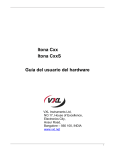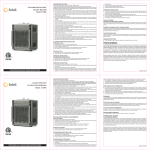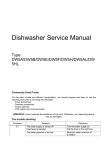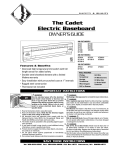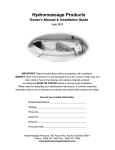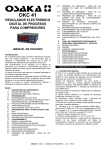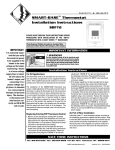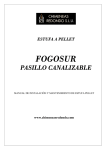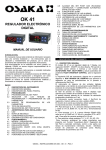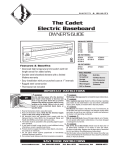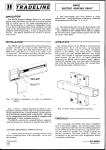Download Cadet SBFT2W Instructions / Assembly
Transcript
SMART-BASE SBFT2 PROGRAMMING THE AUTO SCHEDULE: Default Settings: Day of the Week MO TU WE TH FR SA SU WAKE RETURN LEAVE SLEEP 5:30 AM MANUAL CLOCK NEXT AUTO RUN SCHED Room or Setting Temperature 1 of 2 Operating Modes MODE UP / DOWN Adjust Temperature, Time, Day, Setting & Mode General Programming Operation: 5-1-1 programming allows you to create a heating schedule that is specific to your needs: weekdays, Saturday, and Sunday. Weekdays are a single unit, meaning the program schedule will be the same for Monday, Tuesday, Wednesday, Thursday, and Friday. Saturday and Sunday can each have individual programs. Every weekday, Saturday, or Sunday program has 4 daily settings: WAKE, LEAVE, RETURN, and SLEEP. ✦ WAKE: The desired room temperature and time the heating period should begin when you are present in the morning. If desired, allow 15 minutes prior to wake time for the room to reach comfort level. ✦ LEAVE: The time and the lower desired temperature you would like your room to be when you leave for the day. This is an energy saving period. ✦ RETURN: The desired room temperature and time the heating period should begin when you are present in the evening. If desired, allow 15 minutes prior to your return time for the room to reach comfort level. ✦ SLEEP: The time and the lower desired temperature you would like your room to be while you sleep. This is an energy saving period. Each setting needs to be programmed with a time and temperature. Programming begins by directing you to set the time of day for the 4 daily settings for weekdays, Saturday, and Sunday. Once all times have been set, the program will direct you to set the temperatures for the 4 daily settings for weekdays, Saturday, and Sunday. Setpoint range: 41°F to 86°F (5°C to 30°C). Operation Modes: ✦ The AUTOmatic mode runs the programmed sequence recorded by the user. Use this mode when daily comfort needs and routine are in accordance with the recorded program. ✦ The MANUAL mode overrides the recorded program sequence. Use this mode when out of town or when maintaining a certain temperature set point for an extended period of time is desired. Setting the manual temperature to a cool set point of 62 degrees or less helps reduce energy costs. The MANUAL mode stays active until the AUTOmatic program is activated. ✦ The Temporary Setpoint overrides the programmed temperature when AUTO mode is activated. Set a Temporary Setpoint when changing the temperature for a given period of the day. The setpoint will stay active until the next programmed period for the given day. Energy Saving Tips: Here are a few tips to maximize energy saving capabilities: ✦ When programming, always set the temperature back for a minimum of 8 hours when away from home or asleep. ✦ Each 2-degree decrease for an 8 hour period is equivalent to a 2% savings. ✦ Maximize the 8 hour temperature set back by reducing the setpoint 8 to 10 degrees from your preferred comfort setpoint. ✦ Use the manual mode to set and hold the temperature back 8 degrees or more while on vacation. ✦ Or, maintain default program. The thermostat comes equipped with an energy saving program, as outlined in the “Default Settings” table. The default schedule only applies at the first start of the microprocessor. When the thermostat has been programmed, the default values no longer apply. Programmed values are retained if the heater power is interrupted or turned OFF. Once the power is restored, the thermostat will be in AUTO mode. However, the clock and day of the week will require reprogramming. Before you program your thermostat, take a moment and write a program suitable to your needs and schedule. You will need to know this before programming thethermostat. Use the default settings guide above as a guideline. Programming Instructions: START UP 1.To activate the PROGRAM MODE, press the MODE button once. CLOCK, NEXT, SCHED appear on the display. 2. To activate the AUTO SCHEDULE program mode, press the up ▲ button once. The first display will be the WAKE time for Monday through Friday. Time adjustments are made in 15 minute increments. 3. To program the WAKE time setting, press the down ▼ button to decrease the time or the up ▲ button to increase. When the time setting is correct, press the MODE button to advance to program the LEAVE time setting. 4. To program the LEAVE time setting, press the down ▼ button to decrease the time or the up ▲ button to increase. When the time setting is correct, press the MODE button to advance to program the RETURN time setting. The thermostat will load its default program * Room settings when power is established for Temperature the first time. The display will alternate between a room temperature display and a time of day display. Both the time of day and room temperature displays will continuously flash to indicate that a Time of Day power interruption has occured. How to Press Buttons for Programming: ✦ To change the temperature set point, press the down▼ or up ▲ button and hold, release when desired set point is reached. Temperature increases or decreases in 1 degree increments. ✦ To change the time of day, press the down▼ or up ▲ button and hold, release when desired set point is reached. Time of day increases or decreases in 15 minute increments. ✦ For all other functions, press once to make changes or selections. 5. To program the RETURN time setting, press the down ▼ button to decrease the time or the up ▲ button to increase. When the time setting is correct, press the MODE button to program the SLEEP time setting. 6. To program the SLEEP time setting, press the down ▼ button to decrease the time or the up ▲ button to increase. When the time setting is correct, press the MODE button to program the Saturday WAKE time setting. 9. Continue to program the setpoint temperatures by pressing the MODE button to advance to LEAVE, RETURN and then SLEEP. For each schedule, press either the down ▼ button or the up ▲ button to program the correct setpoint. Press the MODE button to advance. 10. Continue to program the setpoint temperatures for Saturday and Sunday by pressing the MODE button to advance. For each schedule, press either the down ▼ button or the up ▲ button to program the correct setpoint. When you have completed the programming, press the MODE button to save. AUTO AND MANUAL MODES: Selecting AUTO or MANUAL Mode: 1. To select the AUTO or MANUAL operating mode, press the MODE button twice. The MANUAL, RUN, AUTO appear on the display. The current mode is identified by a flashing underline. Press the down ▼ button to select MANUAL mode or the up ▲ button to select AUTO mode. To activate the selected operating mode, press the MODE button again. Adjusting MANUAL Setpoint: 2. To adjust the MANUAL mode setpoint, press either the down ▼ button or the up ▲ button to display the current manual setpoint. To change the setpoint, press the down ▼ button to decrease the setting or press the up ▲ button to increase. The thermostat will automatically return to the time/room temperature display within 30 seconds. Setting the Time of Day and Day of Week: 1. To activate the PROGRAM MODE, press the MODE button. CLOCK, NEXT, SCHED appear on the display. 3. To set the hours, press the down ▼ button to decrease the hour or the up▲ button to advance. Note: the clock is a 24 hour clock and will display AM or PM to distinguish time of day. The AM/PM icon will change with setting the hours. 5. Press the MODE button to activate the set day of week mode. The SU icon will flash. To set the day, press the down ▼ button to select the previous day or the up ▲ button to select the next day. Only the selected day will show on the LCD. Press the MODE button to save your selection. 2. To activate the CLOCK MODE, press the DOWN ▼ button. The hour numerals will flash. 4. Press the MODE button to activate the set minutes mode. The minute numerals will flash. To set the minutes, press the down ▼ button to decrease the minutes or the up ▲ button to advance. 7. To program the WAKE, LEAVE, RETURN and SLEEP time settings for both Saturday (SA) and Sunday (SU), return to the beginning of the PROGRAMMING AUTO SCHEDULE instructions and repeat. 8. After programming the Saturday and Sunday time settings, press the MODE button to program the Monday through Friday WAKE setpoint temperature. To program setpoint temps, press the down ▼ button to decrease the temp or the up ▲ button to increase. When the temperature setting is correct, press the MODE button to advance to program the LEAVE temp. Setting a Temporary Setpoint: 3. To set a temporary setpoint (AUTO mode only), press either the down ▼ button or the up ▲ button to display the current setpoint. To change the setpoint, press the down ▼ button to decrease the setting or press the up ▲ button to increase. TEMP is displayed to indicate that a temporary setpoint is active. The temporary setpoint will be canceled when the next programmed operating setting has been activated (WAKE, LEAVE, RETURN or SLEEP). It may also be canceled by adjusting the setpoint up or down until the TEMP icon disappears. * The SMART-BASE thermostat has been simulated to offer the best performance for a built-in control. The concept is to simulate a midpoint temperature of the room, respond to this setting, and maintain it for optimum comfort. However, keep in mind that temperature variances to this reading could be affected by drafts within the wall area, cold air from flooring or drafts from a nearby window or door. ©2009 Cadet Manufacturing Co. Printed in U.S.A. 10/09 #720002 SMART-BASE Ajustes predeterminados: PROGRAMAR EL HORARIO AUTOMÁTICO: SBFT2 MO TU WE TH FR SA SU WAKE RETURN LEAVE SLEEP 1.Para activar el modo de programación (PROGRAM MODE), pulse el botón Modo (MODE) una vez. Aparecerá CLOCK, NEXT, SCHED (Reloj, Siguiente, Progr.) en pantalla. 2. Para activar el modo de programación Horario automático (AUTO SCHEDULE), pulse el botón ascendente ▲ una vez. La primera pantalla corresponderá a la hora de despertar (WAKE) para los días hábiles. Los ajustes de hora se realizan en incrementos de 15 minutos. 3. Para programar el ajuste de la hora de despertar (WAKE), pulse el botón descendente ▼ para bajar la hora o el botón ascendente ▲ para subirla. Cuando el ajuste de la hora sea el correcto, pulse el botón Modo (MODE) para avanzar y programar la hora de salida (LEAVE). 4. Para programar el ajuste de la hora de salida (LEAVE), pulse el botón descendente ▼ para bajar la hora o el botón ascendente ▲ para subirla. Cuando el ajuste de la hora sea el correcto, pulse el botón Modo (MODE) para avanzar a la programación de la hora de regreso (RETURN). 5. Para programar el ajuste de la hora de regreso (RETURN), pulse el botón descendente ▼ para bajar la hora o el botón ascendente ▲ para subirla. Cuando el ajuste de la hora sea el correcto, pulse el botón Modo (MODE) para programar el ajuste nocturno (SLEEP). 6. Para programar el ajuste nocturno (SLEEP), pulse el botón descendente ▼ para bajar la hora o el botón ascendente ▲ para subirla. Cuando el ajuste de la hora sea el correcto, pulse el botón Modo (MODE) para programar el ajuste de la hora de despertar (WAKE) del sábado. 5:30 AM MANUAL CLOCK 9. Continúe programando las temperaturas pulsando el botón Modo (MODE) para avanzar por las modalidades de salida (LEAVE), regreso (RETURN) y luego nocturna (SLEEP). En cada programa, pulse ya sea el botón descendente ▼ o el ascendente ▲ para programar el punto de ajuste correcto. Pulse el botón Modo (MODE) para avanzar. 10. Continúe programando las temperaturas para el sábado y el domingo pulsando el botón Modo (MODE) para avanzar. En cada programa, pulse ya sea el botón descendente ▼ o el ascendente ▲ para programar el punto de ajuste correcto. Cuando haya completado la programación, pulse el botón Modo (MODE) para guardar. NEXT AUTO RUN SCHED El programa predeterminado sólo es válido la primera vez que funciona el microprocesador. Cuando se ha programado el termostato, los valores predeterminados ya no son válidos. MODE Operación de programación general: La programación 5-1-1 permite crear un programa de calefacción específico para sus necesidades: días hábiles, sábado y domingo. Los días hábiles constituyen una sola unidad, lo cual significa que el horario de la programación será igual para el lunes, martes, miércoles, jueves y viernes. El sábado y el domingo pueden tener programas individuales. Cada programa para días hábiles, sábado o domingo tiene cuatro ajustes diarios: DESPERTAR, SALIDA, REGRESO y NOCHE. ✦ DESPERTAR: La temperatura ambiental y la hora en que desee que comience el período de calefacción cuando usted esté presente en la mañana. Si lo desea, fíjelo 15 minutos antes de la hora en que despierte para que la habitación alcance el nivel de su comodidad. ✦ SALIDA: La hora y la temperatura más baja en la que desee que quede la habitación cuando salga durante el día. Éste es un período de ahorro de energía. ✦ REGRESO: La temperatura ambiental y la hora en que desee que comience el período de calefacción cuando usted regrese a su hogar. Si lo desea, fíjelo 15 minutos antes de la hora en que regrese para que la habitación alcance el nivel de su comodidad. ✦ NOCHE: La hora y la temperatura menor que desee para la habitación mientras usted duerme. Éste es un período de ahorro de energía. Cada ajuste se debe programar con una hora y temperatura. Para comenzar la programación deberá fijar la hora del día para los 4 ajustes diarios de los días hábiles y del sábado y domingo. Una vez que se han fijado todas las horas, el programa le indicará que fije las temperaturas para los 4 ajustes diarios de los días hábiles y del sábado y domingo. Margen de fijación de temperatura: 45˚ - 80˚F (5˚C - 30˚C) Modos de operación: ✦ El modo AUTOmático funciona con la secuencia programada que grabó el usuario. Utilice este modo cuando sus necesidades diarias de comodidad y su rutina concuerden con el programa grabado. ✦ El modo MANUAL supedita la secuencia de programación grabada. Utilice este modo cuando esté fuera de la ciudad o cuando quiera mantener una determinada temperatura durante un período prolongado. Fijar la temperatura manual en un punto de ajuste fresco de 62 grados o menos ayuda a reducir los costos de energía. El modo MANUAL se mantiene vigente hasta que se activa el programa AUTOmático. ✦ El punto de fijación temporal supedita la temperatura programada cuando se activa el modo AUTO. Fije un punto de ajuste temporal al cambiar la temperatura durante un período determinado del día. El punto de ajuste se mantendrá activo hasta el siguiente período programado del día determinado. Consejos para ahorrar energía: He aquí algunos consejos para maximizar el ahorro de energía: ✦ Programe una temperatura menor durante un mínimo de 8 horas cuando no se encuentre su hogar o bien cuando esté durmiendo. ✦ Cada disminución de 2 grados durante un período de 8 horas equivale a un ahorro del 2%. ✦ Aproveche al máximo el período de ahorro de 8 horas fijando su punto de ajuste en 8 a 10 grados menos que la temperatura que prefiere. ✦ Utilice el modo manual para fijar y conservar la temperatura en un mínimo de 8 grados menos cuando esté de vacaciones. ✦ O bien, mantenga el programa predeterminado. El termostato viene equipado con un programa de ahorro de energía, tal como se describe en la tabla “Ajustes predeterminados”. Los valores programados se conservan si la energía del calefactor se interrumpe o se apaga. Una vez que se restablece la energía, el termostato estará en el modo AUTO. Sin embargo, el reloj y el día hábil se deberán reprogramar. Antes de programar el termostato, dedique un momento a escribir un programa adecuado para sus necesidades y horarios. Deberá tener esta información antes de programar el termostato. Utilice los ajustes predeterminados descritos anteriormente como pauta general. Instrucciones de programación: INICIO El termostato cargará los ajustes de su programa *Temperatura predeterminado cuando se conecte la energía ambiente por primera vez. El visor alternará entre la pantalla con la temperatura ambiente y la pantalla con la hora del día. Tanto la pantalla de la hora del día como la de la temperatura destellarán permanentemente para indicar que se ha Hora del día producido una interrupción de la energía. Cómo Presionar Los Botones Para Programar: ✦ Para cambiar la temperatura, pulse ininterrumpidamente el botón descendente▼ o ascendente ▲ hasta llegar al valor que desea, y luego suéltelo. La temperatura aumenta o disminuye en incrementos de 1 grado. ✦ Para cambiar la hora del día, pulse ininterrumpidamente el botón descendente ▼ o ascendente ▲ hasta llegar al valor que desea, y luego suéltelo. La hora del día aumenta o disminuye en incrementos de 15 minutos. ✦ Para todas las demás funciones, vaya pulsando de una sola vez a fin de realizar cambios o selecciones. Fijar la hora del día y el día hábil: 1. Para activar el modo de programación (PROGRAM MODE), pulse el botón Modo (MODE). Aparecerá CLOCK, NEXT, SCHED (Reloj, Siguiente, Progr.) en pantalla. 3. Para fijar las horas, pulse el botón descendente ▼ a fin de bajar la hora o el ascendente▲ para subirla. Nota: el reloj tiene 24 horas y mostrará los indicadores AM o PM para distinguir entre la mañana y la tarde. El icono AM/PM cambiará a medida que se ajusten las horas. 5. Pulse el botón Modo (MODE) para activar el modo de fijación de día hábil. El icono SU destellará. Para fijar el día, pulse el botón descendente ▼ a fin de seleccionar el día anterior o el botón ascendente ▲para seleccionar el día siguiente. Sólo aparecerá el día seleccionado en la pantalla LCD. Pulse el botón Modo (MODE) para guardar su selección. 2. Para activar el modo de reloj (CLOCK MODE), pulse el botón descendente ▼ Los dígitos de hora destellarán. 4. Pulse el botón Modo (MODE) para activar el modo de fijación de minutos. Los dígitos de los minutos destellarán. Para fijar los minutos, pulse el botón descendente▼ para bajar los minutos o el ascendente ▲ para subirlos. 7. Para programar los ajustes de hora de despertar, salida, regreso y nocturna (WAKE, LEAVE, RETURN y SLEEP) tanto para el sábado como para el domingo (SA y SU respectivamente), vuelva al comienzo de las instrucciones de la sección PROGRAMAR EL HORARIO AUTOMÁTICO y repita los pasos. 8. Después de programar los ajustes de horas del sábado y el domingo, pulse el botón Modo (MODE) con el objeto de programar la temperatura para despertar (WAKE) de los días hábiles. Para programar las temperaturas, pulse el botón descendente ▼ para bajar la temperatura o el botón ascendente ▲ para subirla. Cuando el ajuste de la temperatura sea el correcto, pulse el botón Modo (MODE) para avanzar a la programación de la temperatura de salida (LEAVE). MODOS AUTO Y MANUAL: Seleccionar el modo AUTO o el MANUAL: 1. Para seleccionar el modo de operación AUTO o MANUAL, pulse el botón Modo (MODE) dos veces. Aparecerá MANUAL, RUN, AUTO (Manual, Funcionar, Auto) en pantalla. El modo actual se identifica mediante un subrayado parpadeante. Pulse el botón descendente ▼ para seleccionar el modo MANUAL o el botón ascendente ▲ para seleccionar el modo AUTO. Para activar el modo de operación seleccionado, pulse el botón Modo (MODE) nuevamente. Ajustar el punto de fijación MANUAL: 2. Para ajustar el punto de fijación del modo MANUAL, pulse ya sea el botón descendente ▼ o el botón ascendente ▲ para mostrar el punto de fijación manual actual. Para cambiar el punto de fijación, pulse el botón descendente ▼ para bajar el ajuste o el botón ascendente ▲ para subirlo. El termostato volverá automáticamente a la pantalla de hora/temperatura ambiente durante 30 segundos. Fijar un punto de ajuste temporal: 3. Para fijar un punto de ajuste temporal (sólo en el modo AUTO), pulse ya sea el botón descendente ▼ o el ascendente ▲ para mostrar el punto de ajuste actual. Para cambiar el punto de fijación, pulse el botón descendente ▼ para bajar el ajuste o el botón ascendente ▲ para subirlo. Aparece TEMP en la pantalla para indicar que se ha activado un punto de ajuste temporal. El punto de ajuste temporal se cancelará cuando se haya activado el siguiente ajuste de operación programado (despertar [WAKE], salida [LEAVE], regreso [RETURN] o noche [SLEEP]). También se puede cancelar subiendo o bajando el punto de ajuste hasta que aparezca el icono TEMP. * La simulación del termostato SMART-BASE ofrece el mejor rendimiento de un control incorporado. El concepto es simular una temperatura media para el ambiente, responder a este ajuste y mantenerlo para lograr una óptima comodidad. Sin embargo, no se debe olvidar que las variaciones en la temperatura de las lecturas podrían verse afectadas por las corrientes de aire dentro de la zona de los muros, por el aire fresco de los pisos o las corrientes de las ventanas o puertas cercanas. ©2009 Cadet Manufacturing Co. Printed in U.S.A. 10/09 #720002
This document in other languages
- español: Cadet SBFT2W



